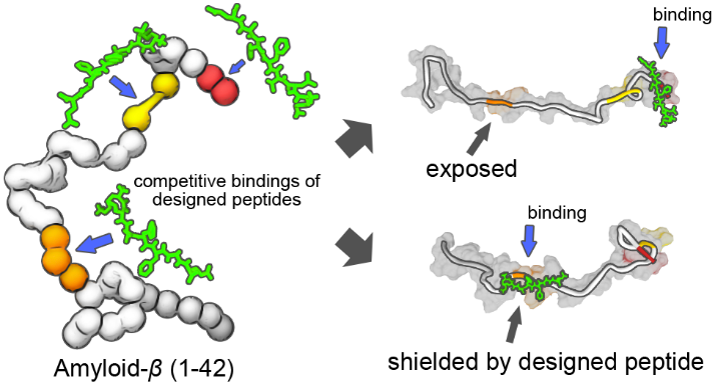Fibrillar amyloid aggregates are the pathological hallmarks of multiple neurodegenerative diseases. The amyloid-β (1-42) protein, in particular, is a major component of senile plaques in the brains of patients with Alzheimer’s disease and a primary target for disease treatment. Determining the essential domains of amyloid-β (1-42) that facilitate its oligomerization is critical for the development of aggregation inhibitors as potential therapeutic agents. In this study, we identified three key hydrophobic sites (17LVF19, 32IGL34, and 41IA42) on amyloid-β (1-42) and investigated their involvement in the self-assembly process of the protein. Based on these findings, we designed candidate inhibitor peptides of amyloid-β (1-42) aggregation. Using the designed peptides, we characterized the roles of the three hydrophobic regions during amyloid-β (1-42) fibrillar aggregation and monitored the consequent effects on its aggregation property and structural conversion. Furthermore, we used an amyloid-β (1-42) double point mutant (I41N/A42N) to examine the interactions between the two C-terminal end residues with the two hydrophobic regions, and their roles in amyloid self-assembly. Our results indicate that interchain interactions in the central hydrophobic region (17LVF19) of amyloid-β (1-42) are important for fibrillar aggregation, and its interaction with other domains is associated with the accessibility of the central hydrophobic region for initiating the oligomerization process. Our study provides mechanistic insights into the self-assembly of amyloid-β (1-42) and highlights key structural domains that facilitate this process. Our results can be further applied toward improving the rational design of candidate amyloid-β (1-42) aggregation inhibitors.

https://pubs.acs.org/doi/10.1021/jacsau.2c00668
 Resonant Raman-Active Polymer Dot Barcodes for Multiplex Cell...
Resonant Raman-Active Polymer Dot Barcodes for Multiplex Cell...
 Flattening bent Janus nanodiscs expands lattice parameters
Flattening bent Janus nanodiscs expands lattice parameters

















